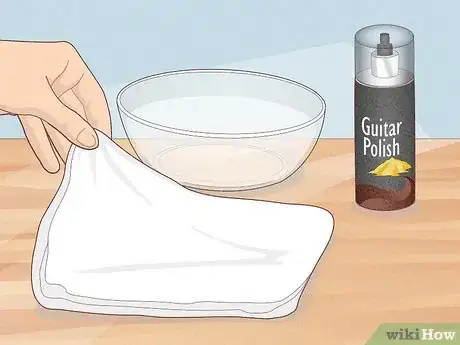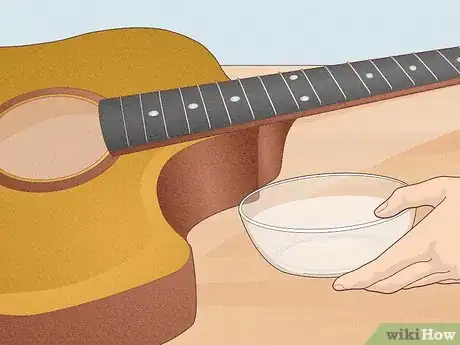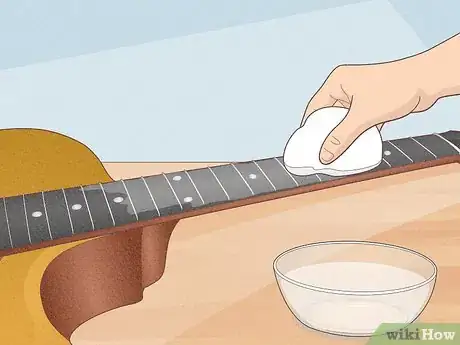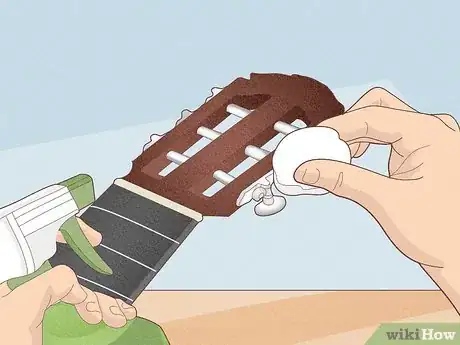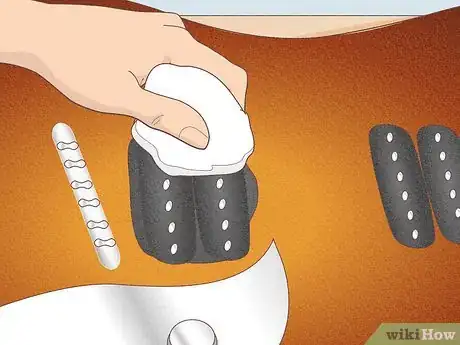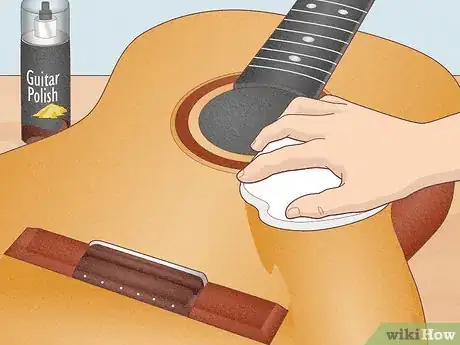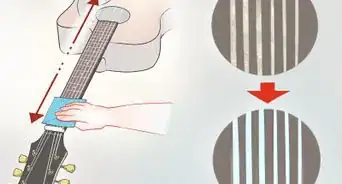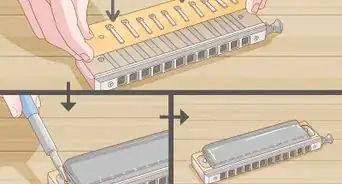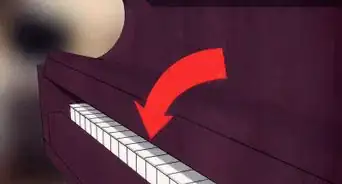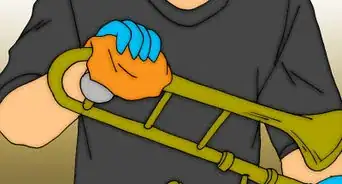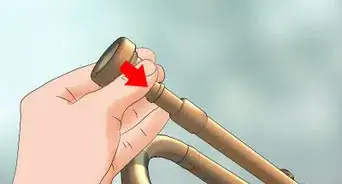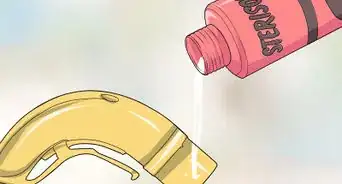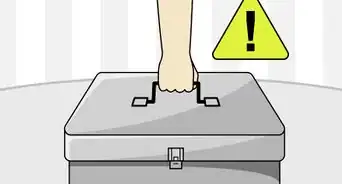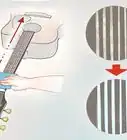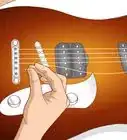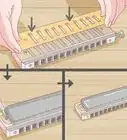This article was co-authored by Nicolas Adams. Nicolas Adams is a 5th generation musician of Serbian Gypsy descent and the lead guitarist of the band Gypsy Tribe. Based in the San Francisco Bay Area, Nicolas specializes in Rumba Flamenco and Gypsy jazz and playing the guitar, Bouzouki, Balalaika, and piano.
This article has been viewed 187,753 times.
Over time as you play your guitar, it's likely going to build up dirt, sweat, grime, and dust and will need a proper cleaning. Cleaning your guitar is a simple process, involving only a few things that you probably have lying around your home and using a bit of elbow grease. Take caution when cleaning certain guitars, like vintage guitars, and make sure you are polishing your guitar with safe products.
Steps
Preparing and Protecting Your Guitar
-
1Gather your materials. Cleaning a guitar requires only a few materials. A soft cloth, like an old t-shirt or a sock, will do the job well, along with some water, glass cleaner, and a guitar polish that contains pure carnauba wax. An electric guitar can be cleaned in the same way as an acoustic.[1]
- If you want to do a heavy duty cleaning on your guitar, you can use white distilled vinegar -- this is a safe product that won't damage the finish on your guitar. You should avoid most household cleaning products that contain silicone, heavy waxes, lacquer thinner, and bleach. All purpose cleaners and furniture polishes are also products you should avoid as they can damage the finish on your guitar.
- Avoid using paper towels to clean your guitar as they can scratch the guitar's finish, especially if it is a lacquer or shellac French polish. Using a cloth that has been laundered many times will work best because it should be mostly free of lint.
-
2Remove the strings. Before your begin the process of cleaning your guitar, it's a good idea to remove the strings so that cleaning your fretboard becomes an easier task. When you change your strings, that may be a good time to clean your guitar. Make sure you only remove a few strings at a time so that you don't mess with the neck tension on your guitar.
- It's important that you remove your strings on your guitar, because as you are cleaning the rest of the guitar you don't want any cleaning products to come into contact with your strings. Your strings should be free of any oils, polishes, or damp cloths that you may use while cleaning.
Advertisement -
3Store your guitar when it's not in use. It can be tempting to display your guitar or to leave it out on its stand when you aren't using it, but the best way to protect your guitar and keep it clean is to put it back in its case.[2]
- If you feel like you need to leave your guitar on its stand so you will remember to play it, make sure the room it is in has about 50 percent humidity. Little humidity can dry the wood out on your guitar, causing the fretboard to shrink and flex.[3]
- If your guitar does show signs of drying out, you can purchase a guitar humidifier and place it in the body of the guitar. Exposing a guitar to humidity can help restore its original look.
-
4Take extra caution with vintage guitars. Vintage guitars with a nitro finish will change color or develop a sheen or patina over time as part of the normal aging process. You want to avoid using polishes on these guitars as they can remove these finishes. Clean your vintage guitars simply with a cloth and a little bit of water.
Cleaning Your Guitar
-
1Clean the fretboard and neck. This is the part of your guitar where the strings are. A fretboard, or fingerboard, should only be cleaned once or twice a year, so that the natural oils and moisture on your guitar that are picked up through the contact with your fingers remain on the guitar. Using your cloth, lightly dampen it with water or distilled vinegar, and gently wipe away the dirt or grime you find on your fretboard.[4]
- When cleaning your guitar, make sure you wring out your damp cloth as much as possible -- you don't want to oversaturate your guitar with water or cleaning products.
- For those really dirty spots on your fretboard, you can use a piece of extra fine #000 or #0000 steel wool to scrub them out. Because steel wool can get caught to the magnets of your pickups, you might want to cover up your pickups if you choose to use steel wool.
-
2Clean the body of your guitar. Moving down the length of your guitar, clean the body of your guitar -- the front, back, and sides -- with the same damp cloth. Make sure you rinse out the cloth so that you don't just spread the dirt to other areas of your guitar. Move the cloth in circular motions across the body of your guitar.[5]
- As you clean your guitar you may notice some spots that don't come off just by wiping them with the cloth. Fingerprints, smudges, or dirtier spots may need a little bit of moisture, so "huff" warm breath on your guitar, just as you would if you were cleaning a window. Then, wipe with the damp cloth. If this still isn't enough you can use a small amount of mild detergent with water. After you have cleaned these spots, buff with a dry cloth to remove streaks.
-
3Clean your bridge as you would the fretboard. The bridge is located on the body of the guitar, below the soundhole, and it supports the strings of your guitar. To clean the bridge of your guitar, use the same method as the fretboard, dampening a cloth and wiping down the bridge to remove dust, dirt, and grime. For the difficult spots, you can use a toothbrush or pipe cleaner to gently scrub away the dirt.[6]
-
4Wipe down the tuning keys. These are the keys at the top of your guitar neck, on the headstock of your guitar. To clean these keys you can spray a dry cloth with glass cleaner and polish each key to bring back the shine.
-
5Polish your pickups. These are usually located on an electric guitar, on the body of the guitar in place of the sound hole. If your pickups look a little dirty you can clean them up with a damp cloth, but if you spot rust on your pick ups, carefully remove them from your guitar. Once you have unscrewed your pickups (using an Allen wrench is an easy way to do this), clean them with a rust-dissolving agent.
- You can also remove rust spots using a white pencil eraser or a cotton ball with a small amount of lighter fluid.
- Once you have cleaned your pickups, screw them back onto your guitar and wipe dry with a clean cloth.
-
6Polish your finish. Some guitar experts suggest not to polish your guitar frequently, as the polish can build up and while it looks nice cosmetically, it may dampen the sound of your guitar. If you are going to polish your guitar, use a polish that contains pure carnauba wax and no solvents or petroleum products. Spray your polish on a cloth and gently wipe down your guitar.[7]
- If your guitar has a satin finish, do not polish or buff it. Buffing a satin finish will cause it to look blotchy.
- You should also avoid polishing vintage guitars. Follow the above directions for how to protect your vintage guitars.
Community Q&A
-
QuestionDoes glass cleaner really work?
 Community AnswerIt depends on what kind of guitar you have, but I would not recommend using it. It may damage your guitar.
Community AnswerIt depends on what kind of guitar you have, but I would not recommend using it. It may damage your guitar. -
QuestionCan I clean the pickups with water?
 Community AnswerJust dampen a cloth and wring it out and be very gentle while cleaning. You may want to use a polish after you're done.
Community AnswerJust dampen a cloth and wring it out and be very gentle while cleaning. You may want to use a polish after you're done. -
QuestionHow can I get a very sticky sticker off of my guitar, a Tacoma Thunderchief CB10C?
 SylghoulsTop AnswererPeel it off your guitar carefully, then clean off the remaining residue with Goo Gone or a similar product. Since the Tacoma Thunderchief CB10C has a body made of wood, make sure the product you use says specifically on their packaging that their solvent won't damage wood finish, and you should be fine.
SylghoulsTop AnswererPeel it off your guitar carefully, then clean off the remaining residue with Goo Gone or a similar product. Since the Tacoma Thunderchief CB10C has a body made of wood, make sure the product you use says specifically on their packaging that their solvent won't damage wood finish, and you should be fine.
Things You'll Need
- Old T-Shirt, or a microfiber towel or a soft terry cotton cloth.
- Tool to remove strings -- Small needle-nose pliers
- New Strings (if you are changing them out)
- Water
- Optional: Rust dissolving product, white distilled vinegar, and glass cleaner
- Tooth brush or pipe cleaner
References
- ↑ http://www.premierguitar.com/articles/19960-guitar-shop-101-safe-ways-to-clean-your-guitars-finish?page=2
- ↑ Nicolas Adams. Professional Guitarist. Expert Interview. 17 September 2019.
- ↑ https://www.taylorguitars.com/sites/default/files/10_SymptomsofaDryGuitar.pdf
- ↑ Nicolas Adams. Professional Guitarist. Expert Interview. 17 September 2019.
- ↑ Nicolas Adams. Professional Guitarist. Expert Interview. 17 September 2019.
- ↑ Nicolas Adams. Professional Guitarist. Expert Interview. 17 September 2019.
- ↑ http://www.premierguitar.com/articles/19960-guitar-shop-101-safe-ways-to-clean-your-guitars-finish?page=2
About This Article
Before you clean your guitar, remove the strings so that no oils or other cleaning products get on them. Then, wipe away dirt or grime on the fretboard with a slightly damp cloth. Next, rinse out the cloth and use it to wash the front, back, and sides of your guitar's body. You can also remove dust and dirt from the bridge with a damp cloth. Finish by polishing your tuning keys with glass cleaner and a cloth. To learn how to polish your pickups on your electric guitar, keep reading!
